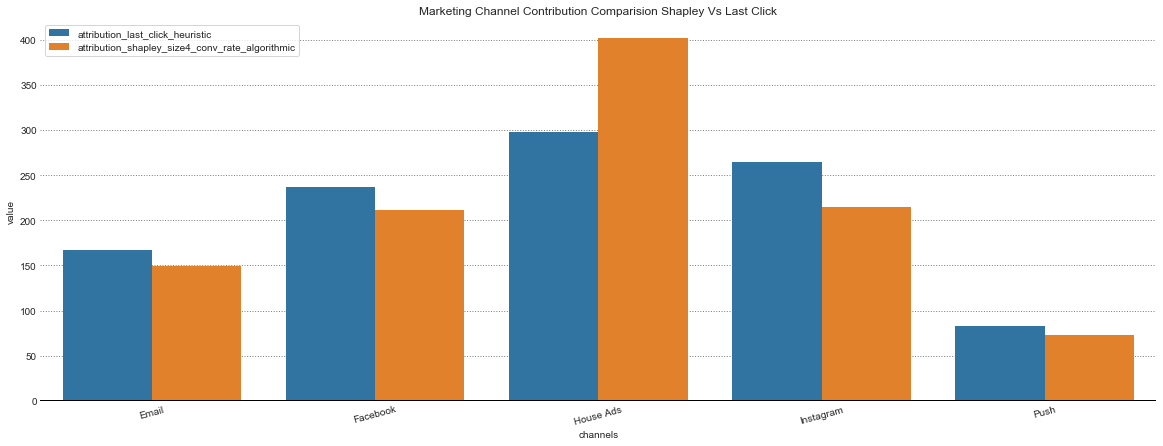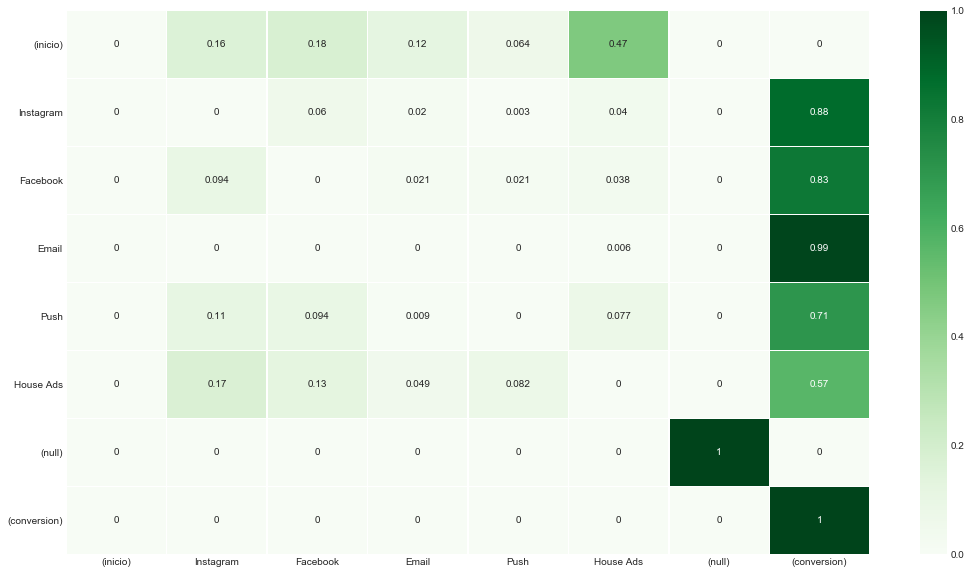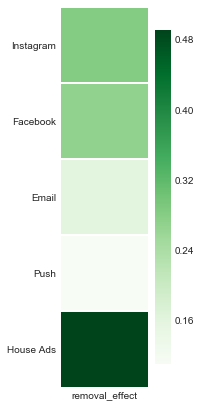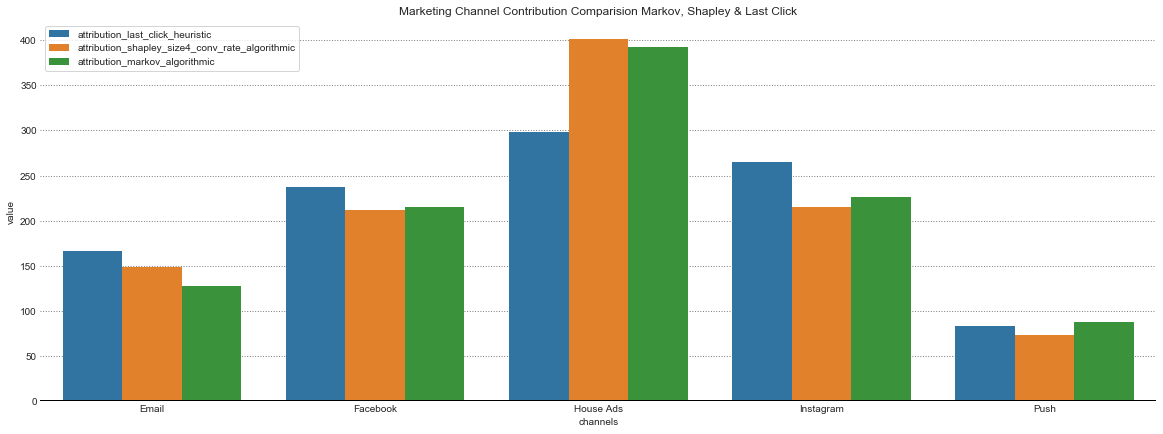Digital Marketing Channels Attribution Models
03 Nov 2020Introduction:
The key strength of digital marketing lies in the the abilities to measure their customer journey and identify how the different channels were resonated with them. Within the context of E-commerce, we could use the information to understand which path they purchase the products on your site or sign up for your memberships. Since Google and Facebook is gradually shifting more traffic to their paid channles, it is essential for any business to build differnet models on their marketing attributions.
In this marketing-attribution project, we will apply following models:
- Rule Based: Last-Click, Time Decay
- Data-Driven Models:
- Shapley Value Models - (Google Analytics is using Shapley Value, However, there is an limitation based on minimum conversions.)
- Markov Chain
It’s remarkbale to think that old-fashioned marketing attribution models until recently that was rule-based is now adopting data-driven models by data analyst across different industry.
For this project, we will beign rule-based marketing attribution models, and then move on to shapley value model and and markov chain model. We will use the sample marketing data from Kaggle. This dataset is the most straight-forward datasets avaliable and we would not spend too much time on data manipulation in this project. For more data cleaning teachniques, check out my data cleaning project.
Import Data and Select Relevent Columns
import numpy as np
import pandas as pd
data = pd.read_csv('marketing.csv')
data.info()
<class 'pandas.core.frame.DataFrame'>
RangeIndex: 10037 entries, 0 to 10036
Data columns (total 12 columns):
user_id 10037 non-null object
date_served 10021 non-null object
marketing_channel 10022 non-null object
variant 10037 non-null object
converted 10022 non-null object
language_displayed 10037 non-null object
language_preferred 10037 non-null object
age_group 10037 non-null object
date_subscribed 1856 non-null object
date_canceled 577 non-null object
subscribing_channel 1856 non-null object
is_retained 1856 non-null object
dtypes: object(12)
memory usage: 941.1+ KB
# creating 'conversion' column with lambda function
data['conversion'] = data['converted'].apply(lambda x: 1 if x == True else 0)
print(data.head())
user_id date_served marketing_channel variant converted \
0 a100000029 1/1/18 House Ads personalization True
1 a100000030 1/1/18 House Ads personalization True
2 a100000031 1/1/18 House Ads personalization True
3 a100000032 1/1/18 House Ads personalization True
4 a100000033 1/1/18 House Ads personalization True
language_displayed language_preferred age_group date_subscribed \
0 English English 0-18 years 1/1/18
1 English English 19-24 years 1/1/18
2 English English 24-30 years 1/1/18
3 English English 30-36 years 1/1/18
4 English English 36-45 years 1/1/18
date_canceled subscribing_channel is_retained conversion
0 NaN House Ads True 1
1 NaN House Ads True 1
2 NaN House Ads True 1
3 NaN House Ads True 1
4 NaN House Ads True 1
# selecting relevent columns for marketing attribution model
Marketing_data = data.loc[:,['user_id','date_served','marketing_channel','variant','subscribing_channel','converted','conversion']]
Marketing_data.head()
| user_id | date_served | marketing_channel | variant | subscribing_channel | converted | conversion | |
|---|---|---|---|---|---|---|---|
| 0 | a100000029 | 1/1/18 | House Ads | personalization | House Ads | True | 1 |
| 1 | a100000030 | 1/1/18 | House Ads | personalization | House Ads | True | 1 |
| 2 | a100000031 | 1/1/18 | House Ads | personalization | House Ads | True | 1 |
| 3 | a100000032 | 1/1/18 | House Ads | personalization | House Ads | True | 1 |
| 4 | a100000033 | 1/1/18 | House Ads | personalization | House Ads | True | 1 |
Marketing_data.info()
<class 'pandas.core.frame.DataFrame'>
RangeIndex: 10037 entries, 0 to 10036
Data columns (total 7 columns):
user_id 10037 non-null object
date_served 10021 non-null object
marketing_channel 10022 non-null object
variant 10037 non-null object
subscribing_channel 1856 non-null object
converted 10022 non-null object
conversion 10037 non-null int64
dtypes: int64(1), object(6)
memory usage: 549.0+ KB
# Drop the Null values in user_id, date_served,etc.
Marketing_data.dropna(axis=0,inplace=True)
Marketing_data.info()
<class 'pandas.core.frame.DataFrame'>
Int64Index: 1856 entries, 0 to 10036
Data columns (total 7 columns):
user_id 1856 non-null object
date_served 1856 non-null object
marketing_channel 1856 non-null object
variant 1856 non-null object
subscribing_channel 1856 non-null object
converted 1856 non-null object
conversion 1856 non-null int64
dtypes: int64(1), object(6)
memory usage: 116.0+ KB
Rule-Based Methods:
An rule-based attribution is using a set of rules that determines how credit/conversion is assigned to different marketing channels in the conversion paths. For example, the last-click attribution model assigns 100% credit to the final touchpoint. It is far to say that rule-based attriution model is defined by human, and therefore, it’s subjective and can be biased towards certain business model.
However, when we havelimited exposure of your marketing data and wants an simple attribution model,a rule-based attribution model would be ideal. In this section, I will use Python based on marketing_attribution_models developed by Andre Tocci. you can find more information here
# Import class and creating MAM object
from marketing_attribution_models import MAM
# Setting the parameters, group_chennels = True if each row in the dataframe is a session of the user's journey.
attributions = MAM(Marketing_data,
group_channels = True,
channels_colname="marketing_channel",
journey_with_conv_colname = 'converted',
group_channels_by_id_list = ['user_id'],
group_timestamp_colname = 'date_served',
create_journey_id_based_on_conversion = True
)
attributions. DataFrame
| journey_id | channels_agg | converted_agg | conversion_value | time_till_conv_agg | |
|---|---|---|---|---|---|
| 0 | id:a100000029_J:0 | House Ads | True | 1 | 0.0 |
| 1 | id:a100000030_J:0 | House Ads | True | 1 | 0.0 |
| 2 | id:a100000031_J:0 | House Ads | True | 1 | 0.0 |
| 3 | id:a100000032_J:0 | House Ads | True | 1 | 0.0 |
| 4 | id:a100000033_J:0 | House Ads | True | 1 | 0.0 |
| ... | ... | ... | ... | ... | ... |
| 1272 | id:a100007290_J:0 | True | 1 | 0.0 | |
| 1273 | id:a100007291_J:0 | True | 1 | 0.0 | |
| 1274 | id:a100007292_J:0 | False | 0 | 0.0 | |
| 1275 | id:a100007293_J:0 | True | 1 | 0.0 | |
| 1276 | id:a100007294_J:0 | False | 0 | 0.0 |
1277 rows × 5 columns
In the table above, we imported the marketing data into a MAM object. Our marketing channels were grouped first by “user_id” then by “converted”. (please refer back to how we are setting the parameters wihtin the MAM). Note: journey_id was generated based on user_id and converted column and serve as the unique identifier.
It is worth noting that it seems like channles_agg column only possess single marketing channels for each id. the reality is far more complex. We will explore the combinations of different marketing channels within customer’s purchase journey in the next part:
Here are some examples of marketing channels combination:
- ‘Push > House Ads
- ‘House Ads > House Ads > Push > Push > House Ads > House Ads > Facebook’,
- ‘House Ads > House Ads > Email > Email > House Ads > House Ads > House Ads > House Ads > Email’
# Unique Marketing Channels Combinations
channels_subset=attributions. DataFrame
channels_subset["channels_agg"].unique()
array(['House Ads', 'House Ads > House Ads', 'Push > House Ads',
'Facebook > House Ads', 'Instagram > House Ads', 'Email', 'Push',
'Facebook', 'Instagram', 'Instagram > Email', 'Facebook > Email',
'House Ads > Facebook', 'House Ads > Instagram',
'House Ads > Email', 'House Ads > Push', 'Push > Facebook',
'Facebook > Instagram', 'Instagram > Push', 'Instagram > Facebook',
'Instagram > Instagram', 'Push > Email', 'Facebook > Push',
'House Ads > Facebook > House Ads > House Ads > Email',
'House Ads > House Ads > House Ads > House Ads > Push',
'House Ads > House Ads > House Ads > House Ads > Facebook',
'House Ads > Push > House Ads > House Ads > Instagram',
'House Ads > Facebook > House Ads > Instagram',
'House Ads > Instagram > House Ads > Instagram',
'House Ads > House Ads > Push',
'House Ads > House Ads > House Ads > House Ads > Instagram',
'House Ads > House Ads > House Ads > House Ads > House Ads > House Ads > Instagram',
'House Ads > House Ads > House Ads > House Ads > House Ads > House Ads > Email',
'House Ads > House Ads > House Ads > House Ads > House Ads > House Ads > Push',
'House Ads > House Ads > House Ads > House Ads > Push > Push > Facebook',
'House Ads > House Ads > House Ads > House Ads > House Ads > House Ads > House Ads > House Ads > Instagram',
'House Ads > House Ads > Push > Push > House Ads > House Ads > Facebook',
'Facebook > Facebook > Instagram',
'Instagram > Instagram > Instagram',
'Instagram > Instagram > House Ads > House Ads > House Ads > House Ads > Facebook',
'Facebook > Facebook > House Ads > House Ads > House Ads > House Ads > Instagram',
'House Ads > House Ads > Email > Email > House Ads > House Ads > House Ads > House Ads > Email',
'House Ads > House Ads > Facebook',
'Instagram > Instagram > House Ads > House Ads > House Ads > House Ads > Instagram',
'House Ads > House Ads > Facebook > Facebook',
'House Ads > House Ads > House Ads > Instagram',
'House Ads > House Ads > House Ads > Facebook',
'House Ads > House Ads > Push > Instagram',
'House Ads > House Ads > Facebook > Email',
'House Ads > Push > Instagram',
'House Ads > House Ads > Instagram',
'House Ads > Facebook > Facebook',
'Instagram > House Ads > Instagram',
'Facebook > House Ads > Instagram > Facebook',
'House Ads > House Ads > Instagram > Instagram',
'House Ads > House Ads > House Ads > Push',
'House Ads > Facebook > Instagram',
'House Ads > Instagram > Facebook',
'House Ads > Instagram > Instagram',
'House Ads > Email > Facebook', 'House Ads > Instagram > Email',
'House Ads > Facebook > Push', 'Push > Instagram',
'Facebook > Facebook', 'Push > Push', 'Email > House Ads'],
dtype=object)
# Adopting Last Click Attribution Model
attributions. attribution_last_click()
# A column with given attribution model will be added at the end of the table.
attributions . DataFrame
| journey_id | channels_agg | converted_agg | conversion_value | time_till_conv_agg | attribution_last_click_heuristic | |
|---|---|---|---|---|---|---|
| 0 | id:a100000029_J:0 | House Ads | True | 1 | 0.0 | 1 |
| 1 | id:a100000030_J:0 | House Ads | True | 1 | 0.0 | 1 |
| 2 | id:a100000031_J:0 | House Ads | True | 1 | 0.0 | 1 |
| 3 | id:a100000032_J:0 | House Ads | True | 1 | 0.0 | 1 |
| 4 | id:a100000033_J:0 | House Ads | True | 1 | 0.0 | 1 |
| ... | ... | ... | ... | ... | ... | ... |
| 1272 | id:a100007290_J:0 | True | 1 | 0.0 | 1 | |
| 1273 | id:a100007291_J:0 | True | 1 | 0.0 | 1 | |
| 1274 | id:a100007292_J:0 | False | 0 | 0.0 | 0 | |
| 1275 | id:a100007293_J:0 | True | 1 | 0.0 | 1 | |
| 1276 | id:a100007294_J:0 | False | 0 | 0.0 | 0 |
1277 rows × 6 columns
#Prep data for the bar chart
last_click_attribution_reasults = attributions . group_by_channels_models
#Import Visualization packages
import matplotlib.pyplot as plt
import seaborn as sns
%matplotlib inline
plt.subplots(figsize=(14,4))
sns.barplot(x='channels', y='attribution_last_click_heuristic', data=last_click_attribution_reasults).set_title('Channel Contribution Based On Last-Click Attribution Model')
plt.ylabel("Contribution Value")
plt.show()

Data Driven Model - Shapley Value
The shapley value was developed by Economics Science winner Lloyd S. Shapley. Based on Cooperative game theory, the shapley value provides a way to measure the contribution of each marketing channels. The basic idea of Shapley value method is to create weighted average of its marginal contribution over all possible coalitions for each channel. In other words, shapley value provides an effective way to measure channel influence and divide the credit fairly across marketing channels.
In order to better implement Shapley Value attribution model, we also need to understand the limitations:
- The Shapley Value is based on combinatory mathematics, and the number of possible coalitions and ordered sequences becomes huge when the number of campaigns increases.
- Channels rarely present or present in long journeys will be played down.
- If unordered, the Shapley Value assumes the contribution of campaign A is the same if followed by campaign B or by C.
- In the marketing context a journey with a high number of channels will not necessarily bring more orders than a journey with less channels involved.
In our package, the default size of marketing channels is set to 4. This size parameter set an limitation on the number of unique channels in each customer’s purchase journey. We need to be careful with the default channel size setting as the number of possible coaliation of marketing channels increases exponentially with the number of channels types.
attributions . attribution_shapley()
attributions.group_by_channels_models
| channels | attribution_last_click_heuristic | attribution_shapley_size4_conv_rate_algorithmic | |
|---|---|---|---|
| 0 | 167 | 149.251648 | |
| 1 | 237 | 211.528757 | |
| 2 | House Ads | 298 | 401.331657 |
| 3 | 265 | 214.678791 | |
| 4 | Push | 83 | 73.209146 |
# Compare the distribution between last click model attribution and Shapley Value.
attributions.plot()
plt.title('Marketing Channel Contribution Comparision Shapley Vs Last Click')
plt.show()

Data Driven Model - Markov Chains
Markov chains is a model describing a sequence of pssoble events in which the probability of each event depends only on the state attained in the previous event. Therefore, the Markov Chain models is path dependent. in the marketing context, Markov chains model provide a way to model conversion funnel. Using this model, two main components need to be cacualted:
- Transition probabilities between all states
- Removal effect of each channels (difference in pobabaility in conversions if one channel is removed)
We won’t go too deep into the Markov chains theory in this article, but if you are intersted to learn more this model. Setosa.io is a good place.
There serveral benefits to adopt Markov Chains Model:
- Dynamic Journey is taken into account
- It is possible to build a conversion path that maps customer journey.
However, This model also has its own limitations:
-
It can be somewhat difficult to set the memory parameter. If we set this parameter too high will lead to over-sensitivity to noise. (“memory parameter”: The number of previous steps that are taken into account to model the transition probability is called the memory parameter of the sequence, and for the model to have a solution must be comprised between 0 and 4.)
-
Long journeys will be overweighted as channels will be counted many times during the Removal Effect.
attribution_markov = attributions . attribution_markov ( transition_to_same_state = False )
# Generating the transition matrix
ax,fig = plt.subplots ( figsize = ( 18 , 10 ))
sns.heatmap(attribution_markov[2].round(3), cmap="Greens", annot=True , linewidths =.5,)
plt.yticks(rotation=0)
plt.show()

# Removal Effect
x,fig = plt.subplots ( figsize = (2,7))
sns.heatmap ( attribution_markov[3] . round (3), cmap = "Greens", annot = False, linewidths =.5 )
plt.yticks(rotation=0)
plt.show()

#Visulization - Comparation of Three Different Attribution Models
attributions.plot()
plt.title('Marketing Channel Contribution Comparision Markov, Shapley & Last Click')
plt.xticks(rotation=0)
plt.show()

Conclusion:
To summarize, the results shows house ads is vital to our marketing campaigns based on our sample data. If we adopt the data-drive method, I could recommend to allocate more resource to the house ads. However, each marketing attribution model has its own unique strengh and limitation. so Which method should we use?
… It really depends on your business …
Rule-Based Attribution Method
- Easy to implement
- Unintegrated marketing data was stored in different platforms
Shapley Value method
- Wider industry adoption
- More straightfoward to the attribution problem which do not take sequence into consideration.
- A cooperative Game Theory (All the marketing channels are working together to improve the total payoff )
Markov chain method
- It considers channel sequence as a fundamental part of the model which is similar to a customer’s purchase journey.
last but not least, I want to give special thanks to my friend, Weisiang Chen, who provided insightful feedbacks for this marketing attribution project.